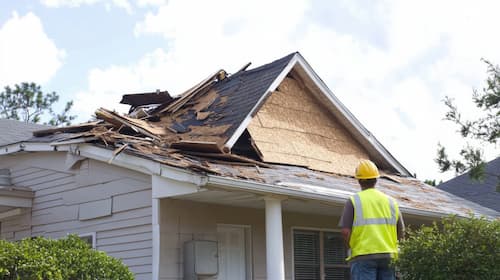Why you can trust Insure.com

Quality Verified
At Insure.com, we are committed to providing the timely, accurate and expert information consumers need to make smart insurance decisions. All our content is written and reviewed by industry professionals and insurance experts. Our team carefully vets our rate data to ensure we only provide reliable and up-to-date insurance pricing. We follow the highest editorial standards. Our content is based solely on objective research and data gathering. We maintain strict editorial independence to ensure unbiased coverage of the insurance industry.
Making sure you have enough home insurance coverage is a vital part of homeownership.
Sure, homeowners would much rather think about redecorating a room or paint colors. But home insurance can be the difference between you being able to rebuild your home if the unthinkable happens or facing financial ruin.
Homeowners insurance rates vary depending on multiple factors, including the size of the home, the building materials and location. Insure.com recently commissioned Quadrant Information Systems to get home insurance rates for major insurers to find the average premiums by state.
We ran the numbers by state to cover a $300,000 dwelling. The policy would include a $1,000 deductible and $300,000 liability coverage since insurance experts usually recommend that level.
Average home insurance rates by state for recommended coverage level
To see rates, enter your state in the search box.
| State | Average annual rate |
|---|---|
| Florida | $5,207 |
| Louisiana | $4,474 |
| Oklahoma | $3,599 |
| Alabama | $3,383 |
| Mississippi | $3,316 |
| Arkansas | $3,040 |
| Kansas | $2,606 |
| Texas | $2,599 |
| Missouri | $2,392 |
| Tennessee | $2,142 |
| Nebraska | $2,123 |
| South Carolina | $2,110 |
| South Dakota | $1,946 |
| Rhode Island | $1,942 |
| Colorado | $1,904 |
| Kentucky | $1,884 |
| West Virginia | $1,877 |
| North Dakota | $1,850 |
| Minnesota | $1,776 |
| Iowa | $1,661 |
| Indiana | $1,630 |
| New Mexico | $1,630 |
| Georgia | $1,601 |
| Massachusetts | $1,599 |
| Montana | $1,594 |
| Michigan | $1,533 |
| New York | $1,429 |
| Wyoming | $1,412 |
| Illinois | $1,406 |
| Virginia | $1,389 |
| Connecticut | $1,323 |
| Alaska | $1,256 |
| Maryland | $1,231 |
| California | $1,200 |
| Ohio | $1,186 |
| Pennsylvania | $1,184 |
| North Carolina | $1,174 |
| Wisconsin | $1,110 |
| Arizona | $1,081 |
| DC | $1,017 |
| New Jersey | $1,012 |
| Delaware | $1,003 |
| Maine | $989 |
| Nevada | $957 |
| New Hampshire | $939 |
| Washington | $896 |
| Oregon | $892 |
| Utah | $879 |
| Idaho | $856 |
| Vermont | $816 |
| Hawaii | $510 |
As you can see, average Floridian homeowners pay $4,700 more than Hawaii homeowners. Why does Florida pay such high rates? Let’s dive in.
Most expensive states with home insurance rates for recommended coverage level
- Florida — $5,207
- Louisiana — $4,474
- Oklahoma — $3,599
- Alabama — $3,383
- Mississippi — $3,316
Least expensive states with home insurance rates for recommended coverage level
- Hawaii — $510
- Vermont — $816
- Idaho — $856
- Utah — $879
- Oregon — $892
Home insurance rates for recommended coverage level by deductible amount
One decision you make when getting a home insurance policy is the deductible. The deductible is what you pay if you file a claim. If your home suffers $10,000 worth of damage and your deductible is $1,000, your insurance company would pay $9,000 for the loss. You would have to pick up the rest.
Deductibles affect your insurance premiums. Choosing a $1,000 deductible will result in lower premiums than if you went with a $500 deductible for the same policy.
Here’s how the average costs differ for $300,000 dwelling coverage with $300,000 liability coverage:
- $500 deductible: $1,866
- $1,000 deductible: $1,737
- $1,500 deductible: $1,667
- $2,000 deductible: $1,566
- $2,500 deductible: $1,545
It’s wise to choose a deductible that you can afford if you file a claim, but don’t have it so low that you would pay more for premiums.
Why is home insurance so expensive in some states?
Home insurance companies base their rates on risk. That includes the risk of the specific home and the area.
When creating rates, insurers review claims for the geographic area. Places with more claims have higher rates.
For instance, let’s say you live in Florida near the ocean. Hurricanes have battered your area and you’ve needed to file a claim.
In that case, your insurance rates will be higher than a community that’s away from the coast and especially in a part of the country that doesn’t get severe weather.
Insurance companies drill down to look at claims activity by ZIP code and even at the neighborhood level. So, yes, your neighbors’ claim history plays a part in your homeowners’ insurance rates.
It’s all about risk. Multiple claims in a neighborhood for fires, burglaries and vandalism will make an insurer think your area is high risk.
This is true for high-crime areas. It’s also the case for places without full-time firefighters or nearby fire hydrants. That all factors into your premiums. We found that not living within five miles of a fire station increases your rates by 3% on average. However, those that live much closer to a central fire station may be eligible of a home insurance discount. We found homeowners receive an average discount of 4% for living near a fire station and 3% for living near a police station.
All of these factors also play a role in state-wide rates. Florida and Louisiana, which we found have the highest rates, are on the frontlines during hurricane season. That increases an area’s insurance rates.
On the other side, those with the lowest home insurance rates are places that don’t usually get hit with major storms, so their rates are lowest.
Of course, storm damage is just one factor for insurance rates. Major forest fires that spread to homes could also cause spikes in homeowners insurance rates.
The riskier your home is to catastrophe, the higher your insurance rates.
QuickTake
What home insurance covers
Home insurance is usually broken down into five categories: Dwelling, personal property, loss of use, liability and other structures.
- Dwelling covers your home if a covered peril, such as fire and vandalism, damages it.
- Personal property covers your possessions. That includes furniture, electronics and clothing. The coverage is usually between 50 percent and 70 percent of your home’s worth. You can get more coverage if you need it.
- Loss of use assists you with living expenses if you need to vacate your home if it’s damaged and being repaired or rebuilt.
- Liability covers you if someone files a claim or sues you or a family member living with you.
- Other structures covers the detached structures on your property, such as a shed, garage and fence.
Recommended home insurance levels
Having home insurance is an essential part of homeownership, but you need to make sure you’re covered adequately. Unlike auto insurance, states don’t mandate that everyone have home insurance or require minimum levels of coverage. It’s still critical that you’re covered and have enough insurance in case the unthinkable happens.
One common mistake is not having enough liability insurance. Liability coverage often starts at $100,000, but that’s usually not enough. That’s because your home is likely your greatest asset.
Liability is the part of the policy that protects you if you’re sued or have a claim filed against you for bodily injury or property damage inflicted by you or a family member living with you.
If you’re sued, the plaintiff may go after your house. If you don’t have enough liability insurance, you could lose your home.
Insurance experts recommend at least $300,000 worth of liability insurance. Liability insurance goes up to $500,000. How much you actually need depends on your assets. If you have multiple homes in high-priced areas, you may need at least $500,000. You can get umbrella insurance if $500,000 isn’t enough protection. Umbrella insurance offers coverage of up to $5 million.
Beyond liability coverage, another vital decision is whether you decide to get replacement value or actual cash value if your home is destroyed.
Replacement value provides you the money you need to replace your current home.
Actual cash value pays you what your home is currently worth. If your home is 50 years old, the insurer would pay you for a 50-year-old home. Not what it would cost to replace that home.
Replacement value, which experts recommend, is more expensive. It’s based roughly on a formula that takes into account a home’s square footage and multiplying that by the cost to rebuild.
Building costs vary by area, so you need to get your local building costs to figure out replacement value. A home in a low-value area will have lower per square foot building costs than one in a high-value area. You can get the specifics for your area from your realtor, a local builders’ association, a reputable builder or your insurance company or agent.
Make sure to use local numbers and not the national average. Using the national average could mean you have too much coverage (and higher premiums than you need) or not enough coverage.
Now, let’s go over an example. Let’s say your local building costs are $100 per square feet. Your home is 2,500 square feet. You multiply the two and your estimated replacement cost would be $250,000.
That’s only an estimate. More plays into replacement cost, including the number of rooms and special features, such as garages and fireplaces. If your home has five fireplaces, replacing your home will cost more than a similar house with no fireplaces.
Work with your insurance company or broker to make sure you have enough replacement coverage, so you can replace your home if it’s destroyed.
Shop around for home insurance
We’ve given you the average rates by state, but premiums vary by company. That’s why it’s vital to shop around.
A good place to start is the Home Insurance Advisor. Our tool asks you a handful of questions about your situation and current home policy to help you identify potential problem spots.
Once you figure out what you want for coverage, including deductible and liability insurance, get quotes from multiple home insurance companies. This will allow you an apples-to-apples comparison.
Also, ask each insurer about discounts. Insurance companies offer discounts for bundling your home and auto and home security systems. See what discounts they have and how much that would reduce your premiums.
Just as important as getting an inexpensive home insurance policy is finding a reputable company. Check out Insure’s Best Home Insurance Companies, where you can explore the ratings for 15 home insurance companies.








